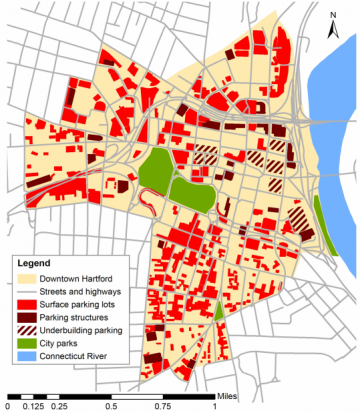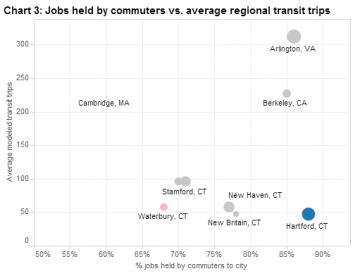
The downtown Hartford campus of the University of Connecticut gained final approval this week, a move that UConn President Susan Herbst expects will bolster the city’s economy by attracting “a huge influx of visitors studying and working daily on the new campus.” Hartford Mayor Pedro Segarra echoed that sentiment, citing the 2,500 students, faculty and staff that he expects “will generate an infusion of activity” in the capital city.
It was also announced this week that the Double-A New Britain Rock Cats baseball team will also move to downtown Hartford, bringing up to 9,000 fans to a yet-to-be-built stadium on the northern edge of downtown 75 nights each year (and potentially more for concerts and other events).
Minor-league baseball is great entertainment, and it would be lovely to have it in Hartford. Downtown residents and workers could walk to the games… it would undeniably bring more feet to the street and more jobs and tax revenue to the city. Along with a UConn campus opening on Prospect Street in 2017… a top-of-the-line baseball stadium would give Hartford the vibrancy it needs.
Having more people downtown could mean more foot traffic and an economic boost for local businesses. And it’s easy to imagine that “shops, restaurants, a bar or two” and more could spring up near the new stadium, or that new retail and dining establishments geared toward college students might set up shop near the Hartford Times Building, the centerpiece of the new UConn campus.
But in order to revitalize downtown Hartford, the City will need to do more to address a street network that is disjointed and congested largely because of one reason: an oversupply of parking. Unlike nearby mid-sized employment centers like Stamford and White Plains, Hartford isn’t served by frequent inter-city transit, so just about everybody drives to get there. On top of that, many Hartford streets “were progressively re-engineered to accommodate more private vehicles at ever higher speeds” at the expense of the pedestrian and cycling environment, leaving a downtown that suffers from “underpopulated sidewalks [that] appear unwelcoming and even forbidding.”
Dr. Norman Garrick of the University of Connecticut’s Center for Transportation and Livable Systems found that Hartford’s downtown parking supply has tripled since 1960, and since then Hartford’s fortunes have fallen. According to Dr. Garrick, “Over the period that parking was being increased by more than 300 percent, downtown was losing more than 60 percent of its residential population, and the city as a whole lost 40,000 people and 7,000 jobs.”

Unfortunately, it seems few lessons have been learned from this research. At least one person thinks the lack of on-site parking at the new UConn campus is enough of a reason to “rethink its plans to move its Greater Hartford campus from West Hartford” where there’s on-site parking. And Hartford Courant columnist Jeff Jacobs called parking “a vital part of the minor league experience,” emphasizing the importance of cheap parking and easy vehicular access to the new stadium, which the City plans to build near the intersection of Interstates 84 and 91.
There is hope, however, to roll back the City’s overreliance on parking as an economic development strategy. By the time UConn-Hartford and the new stadium open, CTfastrak bus rapid transit service will already be running between Hartford and New Britain, the much touted iQuilt Plan, which hopes to improve connectivity in the City with better walking and biking infrastructure, will be close to full implementation, and commuter rail will be running between New Haven, Hartford and Springfield.
If Hartford is serious about becoming more “culturally vibrant, environmentally sustainable, and economically prosperous,” then it has to be more than just a great place to store an empty vehicle. Eliminating mandatory parking requirements for downtown restaurants and launching a study to determine how to get rid of some surface parking lots was a good start. The next step is to leverage these new investments in transit — which will do more for street activity downtown than relocating a university or baseball team — by providing incentives to develop and preserve residential and commercial real estate in downtown and around transit stops instead of subsidizing parking.

[…] To Take Advantage of Downtown Population Bump, Hartford Needs to Get Rid of Some Parking (TSTC) […]
[…] Cutrufo at Mobilizing the Region says some locals are already asking whether parking will be a hindrance. It will, he says, just […]
Folks in City Hall have not really answered how this stadium would fit into its Plan of Conservation and Development. Mayor Segarra has even said this is about “harnessing” the vehicles in the area.
[…] being that this is Hartford, of course there will be plenty of parking. The proposal for Downtown North calls for […]
[…] New Britain itself, though physically dominated — not unlike some parts of downtown Hartford — by an enormous parking garage, has some beautiful architecture and clearly stands to […]
[…] Cutrufo at Mobilizing the Region says some locals are already asking whether parking will be a hindrance. It will, he says, just not […]
[…] 84 through the heart of the city and demolishing historic communities. And since 1960, the supply of surface parking downtown has tripled. In the city of Hartford, 35.7 percent of households do not have access to a vehicle, yet 22 […]